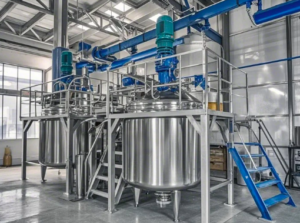A mixing tank with agitator is essential equipment for food processing, pharmaceuticals, chemicals, and cosmetics. Its primary function is to blend, emulsify, or dissolve substances, ensuring a homogeneous mixture. The agitator inside the tank ensures even material distribution, improving the final product’s quality and consistency. This article explores the key functions, benefits, and operational considerations of a mixing tank with agitator.
Key Functions of a Mixing Tank with Agitator
1. Ensuring Homogeneity
The primary purpose of a mixing tank with agitator is to ensure uniform mixing of materials. This is critical in industries where consistency in texture, flavor, or chemical composition is required. For example, in food processing, it ensures uniformity in sauces or beverages. In pharmaceuticals, it helps distribute active ingredients evenly in suspensions and creams.
Agitators come in various designs and speeds, depending on the viscosity of the material being mixed. Low-viscosity liquids may only require simple impellers, while high-viscosity substances need more powerful agitators like turbines or helical screws to achieve optimal mixing.
2. Promoting Chemical Reactions
In chemical processes, a mixing tank with agitator helps accelerate reactions by ensuring that reactants mix efficiently. This is essential in industries like chemicals and pharmaceuticals, where precise formulations and reactions are needed for consistency. Agitation also helps in maintaining an even temperature throughout the tank, which is crucial for reactions requiring specific heat conditions.
Benefits of Using a Mixing Tank with Agitator
 1. Enhanced Production Efficiency
1. Enhanced Production Efficiency
A mixing tank with agitator improves production efficiency by reducing mixing times. Proper agitation can cut mixing time by up to 50%, leading to faster processing and better throughput. This increased efficiency helps businesses meet production targets and reduce costs.
Furthermore, uniform mixing reduces material waste and ensures that final products are consistent in quality, minimizing defects that could lead to rework or waste.
2. Versatility in Various Applications
A mixing tank with agitator is versatile and can handle a variety of materials, including liquids, slurries, and pastes. In the food industry, it is used to blend sauces, dairy products, and beverages. In pharmaceuticals, it is used to create creams, gels, and emulsions. These tanks come in different sizes, from small laboratory units (50-100 liters) to large industrial tanks (several thousand liters), making them suitable for both small-scale and large-volume production.
Operational Considerations for a Mixing Tank with Agitator
1. Regular Maintenance and Cleaning
To ensure a mixing tank with agitator operates effectively, regular maintenance is essential. Cleaning prevents contamination, especially in food and pharmaceutical industries, where hygiene is critical. The agitator should be checked for wear and tear to maintain optimal mixing efficiency.
2. Choosing the Right Agitator Design
The agitator design plays a key role in the mixing process. For high-viscosity materials, a ribbon or screw agitator is ideal, while low-viscosity liquids can be mixed with simpler impellers. Selecting the appropriate agitator based on the materials being processed helps improve mixing efficiency and ensures consistent results.
In conclusion, a mixing tank with agitator is vital for industries requiring efficient, consistent, and homogeneous mixing. By enhancing product quality, promoting chemical reactions, and improving production efficiency, these tanks are crucial to achieving reliable outcomes. Proper maintenance and selecting the right agitator design are essential for optimal performance and long-term operation.
